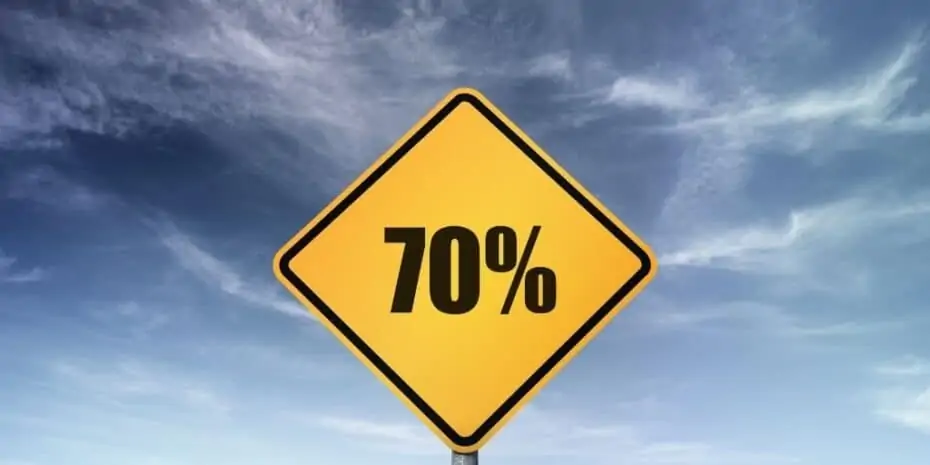What Is the 70% Rule?
REtipster does not provide tax, investment, or financial advice. Always seek the help of a licensed financial professional before taking action.
The Importance of the 70% Rule
When a real estate investor follows the 70% rule, their objective is to buy a property at a fraction of the price it could be resold for at market value, after any necessary repairs have been made.
The 70% rule is a general guideline an investor can use to determine whether or not a property would be profitable and worth pursuing as a fix-and-flip.
For example, if a property’s ARV is $100,000, the 70% rule says that the investor can spend up to $70,000 to purchase the property and make any necessary repairs. If the investor estimates that the repair cost is $20,000, then the rule says that their maximum allowable offer (MAO) is $50,000.
However, the 70% rule does not guarantee profit; it only gives the investor some margin to settle unexpected costs when flipping a property. For instance, if the investor’s estimate is off on their estimated rehab costs, the remaining 30% should cover other expenses, such as agent commissions and payments to lenders[1], also known as “soft costs.”
The 70% rule requires an estimate—but an informed and honest one. The investor should have a realistic grasp of the property’s value after repairs and a modest estimate of the total repair cost. If the investor miscalculates either the ARV or the repair cost (by undervaluing it), they will risk losing their projected profit margin, or worse, lose money.
What Is the Formula for the 70% Rule?
To calculate the 70% rule, multiply the after-repair value (ARV) by 0.7, then subtract the cost of repairs.
The formula below represents finding the maximum allowable offer using the 70% rule[2].
MAO = (ARV * 0.7) – Total Repair Costs
This results in a 30% margin to cover the investor’s unexpected costs.
Want to run the calculations yourself? Try our easy 70% rule calculator below!
Can the 70% Rule Be Adjusted?
The 70% rule is not a requirement, nor is it set in stone. Flippers may tweak the 70% rule depending on the property market and/or location. For example, if the property is in a lower-end market, an investor might adjust the rule to 65% instead of 70%. On the other hand, for a higher-end market, the 70% might be adjusted to higher values, such as 85%[3].
If the investor makes the calculations based on the 70% rule and realizes the profits are smaller than they were hoping for, they can adjust the rule until they come up with a more acceptable figure.
The investor’s exit strategy may also influence how much the investor sticks to the 70% rule. Some exit strategies allow the investor to purchase property at more than the 70% rule, while others may force them to be as close as possible to 70% or even lower (such as a fix-and-flip, which has more associated costs)[4].
Is the 70% Rule Reliable?
The 70% rule is more of a general guideline than a hard and fast rule. It is a tool that allows the investor to arrive at a more accurate assessment of their property purchase in terms of making a profit.
While useful, the 70% rule should not be considered the only factor when benchmarking a property’s profitability. An investor who tries to apply the 70% rule on every property purchase may find that the rule may shut them out of other opportunities, even hinder their money-making potential. In fact, some real estate investors even forgo the 70% rule completely, as it may not work in certain markets or situations[5], and other ways to “force” a profit may be more appropriate.
In addition, the investors should also note that gross figures are misleading; the 30% is never a bulletproof guarantee that they will earn 30% profit. Depending on the investor’s exit strategy, they may have to dip into their 30% profit to cover unexpected costs[6], especially if they intend to flip the property.
The 70% Rule in Real Estate vs. the Rule of 70 in Investing
The 70% rule in real estate is not to be confused with the rule of 70 in finance. The latter is a way to determine how many years it would take for a variable to double. This is done by dividing the number 70 by the growth rate of the variable[7].
For example, if someone invests $10,000 at a fixed annual interest rate of 10%, it would take an estimated seven years for the investment to double (to $20,000).
Like the 70% rule in real estate, the rule of 70 is not set in stone. Investors may even use 72 instead of 70 in the calculation above, similar to how real estate investors may adapt the 70% rule to their plans and strategies.
Takeaways
The 70% rule is more of a guideline than a rule, which helps real estate investors, particularly house flippers and rehabbers, to purchase properties at 70% of their after-repair value. While the main goal is to profit (by 30% at most), the 70% rule will give the investor some wiggle room to pay for unexpected expenses when closing the deal without losing money. It is not set in stone, nor is it a guarantee that the deal will be profitable.
Investors can calculate the maximum allowable offer under the 70% rule by multiplying the ARV of a property by 0.7, then subtracting the result by the estimated repair costs. However, the investor needs to keep in mind that both the ARV and total repair costs can vary, and the accuracy of the figures relies on conservative and realistic estimates.
Sources
- Ball, M. (2020.) What Is the 70% Rule in House Flipping? LoftyAI. Retrieved from https://www.lofty.ai/blog/what-is-70-rule-in-house-flipping
- The Wholesalers Toolbox. (n.d.) Lesson 13: Calculating The Maximum Allowable Offer (MAo). Retrieved from https://www.thewholesalerstoolbox.com/maximum-allowable-offer.html
- Anchor Loans. (2020.) The 70% Rule of House Flipping. Retrieved from https://www.anchorloans.com/fix-and-flip/fixing-and-flipping-with-the-70-percent-rule.
- Feltus, C. (2014.) What Is the 70% Rule—And Is It Important for Your Investing Strategy? BiggerPockets. Retrieved from https://www.biggerpockets.com/blog/70-percent-rule
- Deberry, D. (n.d.) The 70% Rule In House Flipping Is 100% Outdated. The Flipstress®. Retrieved from https://theflipstress.com/the-70-rule-is-wrong
- Ivy, M. (2019.) How Much Does It Cost to Flip a House? 4 Key Factors to Consider. Fit Small Business. Retrieved from https://fitsmallbusiness.com/cost-to-flip-a-house/
- Evans, K. (2021.) What Is the Rule of 70 and How Do Investors Use It? GOBankingRates. Retrieved from https://www.gobankingrates.com/investing/strategy/rule-of-70/





